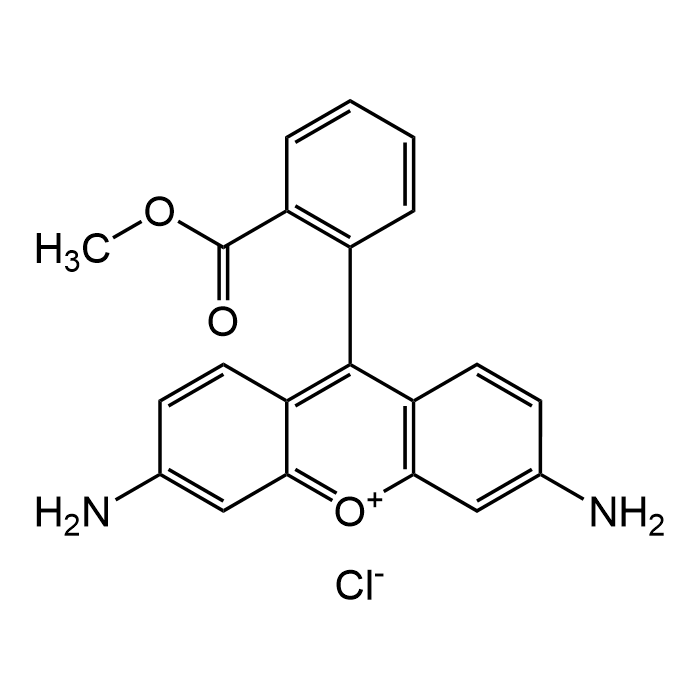Cookie Policy: This site uses cookies to improve your experience. You can find out more about our use of cookies in our Privacy Policy. By continuing to browse this site you agree to our use of cookies.
Chemodex
Rhodamine 123 (chloride)

| Product Details | |
|---|---|
| Synonyms | 2-(6-Amino-3-imino-3H-xanthen-9-yl)benzoic acid methyl ester |
| Product Type | Chemical |
| Properties | |
| Formula | C21H17N2O3 . Cl |
| MW | 380.83 |
| CAS | 62669-70-9 |
| RTECS | ZE0883000 |
| Source/Host Chemicals | Synthetic |
| Purity Chemicals | ≥85% (HPLC) |
| Appearance | Red to very dark red-brown powder. |
| Solubility | Soluble in ethanol (10mg/ml) or DMSO (10mg/ml). |
| Identity | Determined by 1H-NMR. |
| Declaration | Manufactured by Chemodex. |
| Other Product Data |
Click here for Original Manufacturer Product Datasheet |
| InChi Key | MYFATKRONKHHQL-UHFFFAOYSA-N |
| Smiles | O=C(C1=C(C2=C3C=CC(N)=CC3=[O+]C4=C2C=CC(N)=C4)C=CC=C1)OC.[Cl-] |
| Shipping and Handling | |
| Shipping | AMBIENT |
| Short Term Storage | +4°C |
| Long Term Storage | -20°C |
| Handling Advice | Protect from light and moisture. |
| Use/Stability | Stable for at least 2 years after receipt when stored at -20°C. |
| Documents | |
| Product Specification Sheet | |
| Datasheet |
 Download PDF Download PDF |
Rhodamine 123 is a membrane-permeable cationic dye that is readily accumulated within living cells. It is a substrate for the efflux pump P-glycoprotein (P-gp; also known as multidrug resistance protein 1 and ABCB1) and is rapidly exported from cells with functional P-gp. As P-gp is expressed on a population of stem cells known as the side population, rhodamine 123 is used to detect this group of stem cells. It is possible to use rhodamine 123 for detecting cancer cells since it is selectively localized in cancer cells, and its fluorescence is closely related to the alterations in mitochondrial distribution. Rhodamine 123 also accumulates within mitochondria due to its positive charge and can inhibit oxidative phosphorylation. Rhodamine 123 is a popular green fluorescent mitochondrial dye that stains mitochondria in living cells in a membrane potential-dependent fashion. It is utilized for staining a wide variety of cells, including plant cells and bacteria. Like JC-1, rhodamine 123 is used for measuring mitochondrial membrane potential besides its selective mitochondrial staining. It is widely used in flow cytometry studies. Functional assays for MDR proteins are better prognostic indicators in cancer therapy than levels of MDR protein expression. The spectral properties of rhodamine 123 similar to those of FITC make the use of rhodamine 123 quite convenient as almost all fluorescence instruments are equipped with excitation source and filter set of FITC. Rhodamine 123 can be used in multiparameter analyses without fluorescence interference in combination with common protein labeling dyes such as PE-Cy5 and AMCA. Spectral Data: Absorbance, 497nm. λEx/λEm (MeOH) = 507/529nm.
(1) L.V. Johnson, et al.; PNAS 77, 990 (1980) | (2) S.D. Bernal, et al.; Science 218, 1117 (1982) | (3) X. Ronot, et al.; Biol. Cell 57, 1 (1986) (Review) | (4) J.M. Millot,et al.; Cytometry 17, 50 (1994) | (5) G.A.Challen & M.H. Little; Stem Cells 24(1), 3-12 (2006) | (6) K.A. Foster, et al.; Prog. Neurobiol. 79(3), 136-171 (2006) | (7) T. Suzuki, et al.; Acta Histochem. Cytochem. 40, 131 (2007) | (8) C. Ferlini & G. Scambia; Nat. Protoc. 2, 3111 (2007) | (9) S. Kahlert, et al.; J. Neurosci. Methods 171, 87 (2008) | (10) L.H. Cygalova, et al.; J. Pharmacol. Exp. Ther. 331, 1118 (2009) | (11) V. Munic, et al.; Eur. J. Pharm. Sci. 41, 86 (2010) | (12) S. Forster, et al.; PLoS One 7, e33253 (2012) | (13) E. Jouan, et al.; Fundam. Clin. Pharmacol. 28, 65 (2014) | (14) A.M. Al-Mohizea, et al.; Pak. J. Pharm. Sci. 28, 617 (2015) | (15) H. Itoh, et al.; Biomed. Rep. 7, 73 (2017) | (16) L.D. Zorova, et al.; Int. J. Mol. Sci. 23, 482 (2022)





